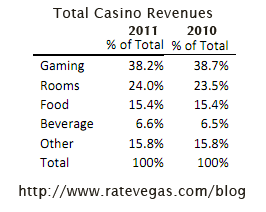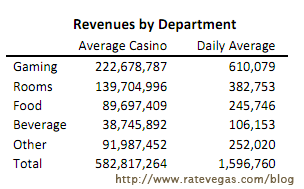Two Way Hard Three | Las Vegas Casino & Design Blog
The Las Vegas Strip: Progress in FY'11
Posted by daveschwartzYesterday I wrote a few reports for the Center for Gaming Research summing up the financial performance of the "average" casino on the Strip, in Downtown Las Vegas, and in Reno. Because people here like talking about the Strip more than, say, Reno/Sparks, I'll break down the Strip results for you.
Interestingly, it seems that two Strip casinos have had their annual gaming revenues dip below $72 million. In FY 2010, there were 23 casinos in that category. In FY 2011, despite the opening of the Cosmopolitan, the total number fell to 22.
First things first: the big picture of how Vegas visitors spent their money at the big casino hotels in FY'11.

As you can see, there's been a small but perceptible shift in the revenue picture. Gaming's piece of the pie shrank by 0.5%, dropping it to 38.2%. Rooms increased by the same amount, with everything else remaining just about constant (Beverage increased by 0.1%, but it all still totals to 100% thanks to the magic of rounding).
This speaks to something that we've all seen: the slow upward creep of room rates. Room rates increased more than eight dollars, from $122.13 to $130.58, in FY 2011. Occupancy picked up (90% -->91%), and so did ADRs, meaning that even though the total amount lost by gamblers in Strip casinos increased by about $200 million ($4.7 billion to $4.9 billion), the percentage of gaming win to total revenues fell.
In other words, exactly what happened in the boom years, only in a more muted way.
This tells me that all of us armchair marketing executives who said that casinos' only path to post-recession profitability would be to offer customers better room and F&B values and hope for more gaming win to make up the difference were wrong. There wasn't any major shift of the model, and certainly no return to the loss-leader days of yore. Instead, once visitation (and particularly the mid-week business travel sector) picked up, casinos were able to raise room rates (and charge more and higher resort fees), leading to gains across the board. "Common sense" analysts 0, "bean-counters" 1.
There was another interesting development: Within the casino the percentage of money won at slots fell from 50.6% to 48.9%. This isn't the first time that's happened--traditionally on the Strip slot and table win alternate in the top spot--but it speaks to the continuing important of high-action play and high rollers. Which means that we'll be seeing more attention paid to ultra-luxe hotel accommodations, since that sector is driving a bigger portion of the business. From this perspective, the answer to the big question of early 2011, "Does it make sense to close Alex?" seems to be "no," to the extent that the same folks who bet big want to eat at Alex.
All in all, the statistically average casino did this kind of business:

Obviously, Wynn and Bellagio did much better numbers than this, but this gives you a sense of the scale of the numbers that Strip casinos deal with.
On to the expense side of the ledger. Here's where it gets interesting. Bad debts, which are traditionally about 2% or so of total Strip casino revenues, inched up from 2.5% to 2.6%. For the year, big Strip casinos wrote off over $124 million as noncollectable. That might seem like enough to get credit managers fired en masse, but when you consider that casinos offered somewhere in the neighborhood of $9.7 billion in credit (15% of total wager guesstimate), it's not so egregious. It comes out to somewhere in the neighborhood of a 1.2% default rate, which might not be too bad in this economy.
Doing the math, I figured that the average Strip casino gets stuck for an average of $15,490 in bad debts per day.
And if you thought Strip casinos were getting stingier with their comps, you might be absolutely right. Casino comps fell in both absolute terms ($1.3 million to $1.2 million) and as a percentage of revenues (28% to 26%).
I'm hedging my declaration that casinos are stingier because two casinos dropped out of this group this year, and since they were obviously two of the lower performers, they likely had a higher comp/revenue ratio than the average. I'd also factor in that some casinos cut comps and the major addition, the Cosmopolitan, was not known for the generosity of its casino comps. So while some casinos might have comped at the same or even higher levels, the average comp for the group dropped.
Also, seeing comp/gaming revenue rates rising isn't necessarily a sign of a more generous casino. It's also a sign of a financially troubled casino that's not recouping its marketing spend. Tropicana Atlantic City, for example, saw its comp ratio rise from a low (for the market) 21.9% in calendar 2003 to 42.3% in 2010. In the long term, that's suicidal: the former AC Hilton's ratio has been above 40% since 2007, which explains...why it's no longer the AC Hilton.
Another interesting comparison: the percentage of room revenues from comped rooms fell from about 25% to about 21%. Casinos comped fewer rooms in 2011.
There's one number that analysts will focus on, and that's return on invested capital, which rose in FY'11 from 0.2% to 1.5%. That's still far below the glory days of the late 1990s but at least it's heading in the right direction.
So all of this tells me not to expect any major strategic changes on the Strip in 2012: operators are doing better under their current models, and no one's going to get fired for continuing to show modest improvements, especially if they didn't already get fired when their company's stock price tanked.
Search
Categories
- About Vegas (38)
- ARIA (21)
- Atlantic City (49)
- Bellagio (90)
- Books (10)
- Boyd Gaming (57)
- Business of Gaming (870)
- Caesars/Harrah's (130)
- Casino Design (369)
- Casino Design Photo of the Week (12)
- CityCenter (158)
- Columbia Sussex (11)
- Condo-Hotels (15)
- Cosmopolitan (20)
- Detroit Casinos (10)
- Device Manufacturers and Games (6)
- Downtown Las Vegas (71)
- Dr. Dave Schwartz (68)
- Fontainebleau (30)
- Gaming Numbers (8)
- Genting (2)
- Interviews (13)
- iPhone (43)
- Landry's (1)
- Las Vegas Photography (98)
- Las Vegas Strip (740)
- Las Vegas/Casino History (3)
- Linq (4)
- Macau Casinos and Hotels (164)
- MGM Resorts International (418)
- Monte Carlo Fire (5)
- Online Gaming (2)
- Open Topics (20)
- Palazzo (59)
- Paolo Mello (1)
- Planet Hollywood (10)
- Podcasts (149)
- Poker (11)
- Press Releases (19)
- RateVegas.com (111)
- Reader Questions (3)
- Reader Reviews (54)
- Simpson on Vegas (38)
- SLS Las Vegas (2)
- Station Casinos (49)
- Strip Walk (32)
- Stripping (Reviews) (13)
- Travel (1)
- Trip Reports (95)
- Tropicana (4)
- Vegas Gang Podcast (115)
- Vegas Internet Mafia Picnic (7)
- Vegas Mate (21)
- Vegas Tips (9)
- Vegas Uncorked (6)
- VegasDelivered.com (1)
- Venetian/LV Sands (198)
- Video (9)
- Wynn Resorts (396)
Subscribe
- Grab our RSS Feed.
New to RSS? Learn more...
Recent Comments
- All Recent Comments on one page.
- bigdaddyj recently commented "Considering how drastically LVS cut comps at Venelazzo earlier in '11, coul..." in The Las Vegas Strip: Progress in FY'11
Archives
- January 2018
- December 2012
- November 2012
- October 2012
- September 2012
- August 2012
- July 2012
- June 2012
- May 2012
- April 2012
- March 2012
- February 2012
- January 2012
- December 2011
- November 2011
- October 2011
- September 2011
- August 2011
- July 2011
- June 2011
- May 2011
- April 2011
- March 2011
- February 2011
- January 2011
- December 2010
- November 2010
- October 2010
- September 2010
- August 2010
- July 2010
- June 2010
- May 2010
- April 2010
- March 2010
- February 2010
- January 2010
- December 2009
- November 2009
- October 2009
- September 2009
- August 2009
- July 2009
- June 2009
- May 2009
- April 2009
- March 2009
- February 2009
- January 2009
- December 2008
- November 2008
- October 2008
- September 2008
- August 2008
- July 2008
- June 2008
- May 2008
- April 2008
- March 2008
- February 2008
- January 2008
- December 2007
- November 2007
- October 2007
- September 2007
- August 2007
- July 2007
- June 2007
- May 2007
- April 2007
- March 2007
- February 2007
- January 2007
- December 2006
- November 2006
- October 2006
- September 2006
- August 2006
- July 2006
- June 2006
- May 2006
- April 2006
- March 2006
- February 2006
- January 2006
- December 2005
- November 2005
- October 2005
- September 2005
- August 2005
- July 2005
- June 2005
- May 2005
- April 2005
- March 2005
- February 2005
- January 2005







Comments
Considering how drastically LVS cut comps at Venelazzo earlier in '11, could we then possible extrapolate from the numbers that the minor drop in overall comp expenditures might actually reflect an increase in comping by everyone else? Shouldn't the overall comp numbers reflect a bigger drop given LVS's "no comp" policy, even if it only really was in place for a few months?
Also, I wonder if the "closing of Alex", combined with the super increase in focus on the club crowd as well as what many (like myself) have seen as a perceptible "downscaling" of Wynncore over the past year, possibly reflect a rare misstep in Steve Wynn's strategy, especially given the fact that the overall beverage revenue increase for the year was practically imperceptible?